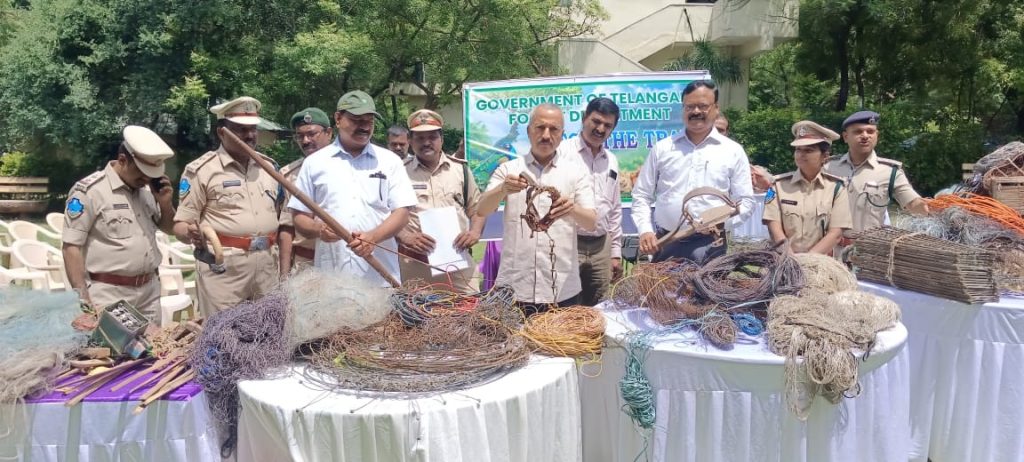Though India passed the Wildlife Protection Act in 1972 to conserve wildlife, most of the times hunting and poaching take place for bushmeat as it is considered a delicacy. Animals are also killed to prevent crop raids. A report by Deepanwita Gita Niyogi

A campaign launched in December last year to prevent the hunting and poaching of wildlife has started giving the desired results in Telangana.
Talking about the initiative over phone, Mohan Pargaien, the former chief wildlife warden of Telangana, said ‘Catch the Trap’ was started as a mission mode across the state so that attention could be focused on this initiative particularly.
“This is because forest officials have a host of other activities to perform, such as tree plantation, which takes place in the long rainy season. Then there is also forest protection, including control of timber smuggling,” the senior forest officer, who was instrumental behind launching the campaign, added.
Though India passed the Wildlife Protection Act in 1972 to protect and conserve wildlife, most of the time hunting and poaching take place for bushmeat as it is considered a delicacy. At times when tigers, elephants and rhinos are killed, it is mainly for trade in body parts. There is also a demand for monitor lizards as its flesh is believed to be an aphrodisiac.
During the pandemic, there was a surge in hunting and poaching cases. Mostly, nets, live wires, traps and snares are used by poachers and hunters.
According to Pargaien, the forest department wanted to focus its attention on this menace. Apart from the deaths of 57 animals due to electrocution from 2021 till June this year, six human deaths also occurred as a result of electrocution from January 2023 to February 2024. “After this, the energy department started coordinating with the forest staff. There have been real impacts on the ground in just six months.” Since the drive was launched, only three cases of wildlife electrocution have occurred.
Tackling the problem
In the tribal-dominated Khammam district, there was a loss of human life due to electrocution by a live wire meant to trap wild animals. Apart from this, two gaurs or Indian bisons, a Schedule 1 species under the Wildlife Protection Act, were also killed.
These two incidents exposed the serious nature of the problem and led to the formation of a district-level monitoring coordination committee, informed SiddharthVikram Singh, the divisional forest officer of Khammam.
“Generally, electric wires are laid by 6 pm and by 5 am they are removed. Patrolling by departmental staff was intensified in areas where there were a high number of poaching and hunting cases. Patrolling turned area specific and the identification of vulnerable and non-vulnerable areas took place to make the drive successful. Early morning and late evening patrolling became the norm.”

Special effort was made by beat and section officers of the forest department who checked transformers and removed illegal live wires. These wires drawn from transformers can be detected for up to 1.5 km.
Singh informed that after witnessing the heightened activities of the forest staff, local inhabitants became serious too. Earlier, people thought that it was a routine check-up.
“The forest department is into monitoring now and trying to gather as much information as possible. There is a district task force team which detects illegal wires and seize materials. Guns have also been seized from people who entered the state from outside.”
India passed the Forest Rights Act in 2006 to recognise the ownership of forest dwellers and tribal communities over forested areas. However, Singh pointed out that it has increased people’s foray inside forested areas through individual pattas or land titles given for cultivation. As regular wildlife movements take place, it is easy to hunt and poach animals.
Use of snares
Sometimes, snares (traps consisting of noose), which cover less surface area, are also used. When used, the animals either die or are badly injured. Snares arrest the movement of animals. After the animals are caught in it, poachers go and beat them to death.

Rudra Mahapatra of the Wildlife Trust of India said the non-profit has introduced anti-snare walks in southern India. There is a plan to introduce it in Odisha too by this year which has a high incidence of bushmeat hunting, especially in and around the Simlipal National Park. In that place, there is a hunting ritual called Akhand Shikar, traditionally carried out by tribals. Apart from Similipal, in the coastal areas, migratory birds are poached as well.
“The anti-snare walk is in collaboration with the forest department where experts walk and remove snares which are simple to make and can kill tigers too. I have even seen elephants receive injuries because of clutch wires used as snares. Currently, the walk is on in Tamil Nadu, Karnataka and Kerala,” Mahapatra said.
Mahapatra said snaring is a modern art and those involved in it know exactly where the animals are. He informed that last year in Kuldiha Wildlife Sanctuary, Balasore district, a bear was caught in a snare.
Coming back to Telangana, B Prabhakaran, the chief conservator of forests, Kaleshwaram circle, said that earlier too the department staff used to do the same work. “But now they are doing it with a concerted effort with the help of the slogan Catch the Trap. It has become a movement.”
Apart from hunting and poaching for bushmeat, farmers also lay wires to prevent wild boars from entering their fields. The aim is crop protection. “The department has seized such wires in remote villages and sent them to Hyderabad. This drive is being appreciated by people too.”
Sensing the success of the campaign, gram panchayats have started giving information based on incentives. The transportation of the seized materials to state capital Hyderabad has helped the department to collect data and study the methodologies used to kill wildlife. Since December 2023, 3810 traps and snares weighing 4872 kg have been seized by the department.













